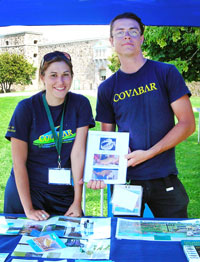Patrol Project in Quebec Aids Copper Redhorse Recovery
October 2010

Information booth at Fort Chambly, near the Richelieu River: The information officers met with numerous visitors to tell them about the copper redhorse.
Photo credit: COVABAR

This female copper redhorse was used for artificial reproduction in 2009.
Photo credit: COVABAR
During the summer of 2010, through the efforts of Comité de concertation et de valorisation du bassin de la rivière Richelieu (COVABAR) awareness officers, nearly 1800 people were informed about the precarious status of the Copper Redhorse, a freshwater fish at risk found nowhere else in the world but in Quebec.
The Copper Redhorse is an endangered species and has been listed pursuant to the Species at Risk Act (SARA). It is estimated that only from a few hundred to a few thousand individuals remain in the Richelieu and St. Lawrence rivers. Numerous activities have been implemented to help this species recover.
The Pierre-Étienne-Fortin wildlife refuge was established in 2002 by the Government of Quebec to protect the larger of the only two known Copper Redhorse spawning grounds. In summer, this natural site is very popular with vacationers for swimming, fishing or activities on the water like personal watercrafting and kayaking. These activities can disturb the fish during the spawning season and are a threat to the recovery o/ f this species. The wildlife refuge is therefore closed to visitors from June 20 to July 20, which is the spawning period for Copper Redhorse. The purpose of this ban on human activity is to minimize the disturbance of spawning stock, the trampling of eggs and any damage to the natural environment. But this can only be accomplished if people respect the rules established for the refuge...
This is why a patrol team has been at work for several years now in the Chambly watershed on the Richelieu River. The awareness officers remind boaters of the existence of the wildlife refuge, of the regulations in force there and of the precarious status of the Copper Redhorse. The officers also meet fishers on the water to make them aware of why it’s important to preserve this species and, using a species identification key, to show them the differences between the Copper redhorse and other fish species.
In 2010, the awareness officers met with 1,779 visitors and recreational boaters and 147 offences were observed.
This patrol project has been made possible through a contribution from the Habitat Stewardship Program for Species at Risk, which is managed jointly by Fisheries and Oceans Canada, Environment Canada and Parks Canada, and with assistance from several other partners, including the Fondation de la faune du Québec.
Other recovery activities are planned by COVABAR for the coming years, including:
- An awareness and guided activity project focusing on Jeannotte and aux Cerfs islands, important nursery areas for the species; and
- A project to restore shorelines in agricultural areas and to raise awareness amongst farmers about the impact of agriculture on the aquatic environment (pesticides, erosion).
Interesting sites
- Species at risk public registry - Copper Redhorse
- Ministère des Ressources naturelles et de la Faune du Québec, Le chevalier cuivré
(In French only) - COVABAR, Les espèces menacées du bassin versant de la rivière Richelieu
(In French only) - Fondation de la faune du Québec
- The Nature Conservancy of Canada
- ZIP des Seigneuries, Caractérisation de l’habitat du chevalier cuivré
(In French only) - Éco-Nature, Les poissons en péril de la rivière des Mille Îles
(In French only)
- Date modified: